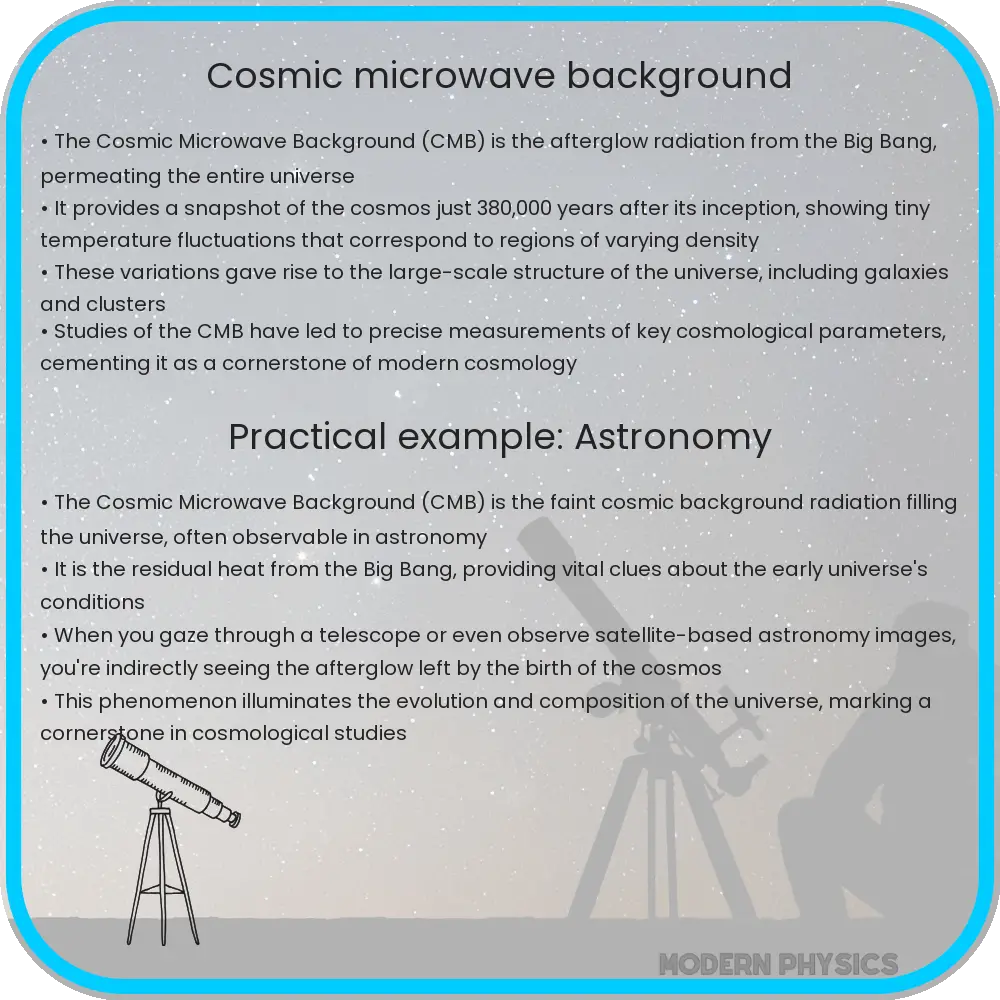Explore the origins, patterns, and significance of the Cosmic Microwave Background (CMB) and how it shapes our understanding of the universe’s history.

Origins of the Cosmic Microwave Background
The Cosmic Microwave Background (CMB) is often considered the afterglow of the Big Bang, the monumental event that gave birth to the universe. Approximately 13.8 billion years ago, the universe was in a state of extreme heat and density. As it expanded, it cooled, leading to a pivotal moment known as recombination, occurring around 380,000 years post-Big Bang. During recombination, electrons and protons combined to form neutral hydrogen atoms, making the universe transparent to radiation for the first time. This transition released photons, or light particles, that had been trapped within the hot plasma of the early universe. These photons are what we now observe as the CMB.
Patterns in the Cosmic Microwave Background
The CMB is not perfectly uniform; instead, it contains slight temperature fluctuations or anisotropies. These variations are incredibly small, on the order of microkelvins (μK), yet they provide a wealth of information about the early universe, the nature of cosmic structures, and the fundamental parameters of cosmology. The patterns observed in the CMB, such as hot and cold spots, are related to the density fluctuations in the early universe. These fluctuations eventually led to the formation of galaxies and large-scale structures we see today.
The detailed study of these patterns has been made possible through missions such as NASA’s Cosmic Background Explorer (COBE), the Wilkinson Microwave Anisotropy Probe (WMAP), and the Planck satellite. These missions have mapped the CMB with increasing accuracy, providing insights into the universe’s age, composition, and development.
Significance of the Cosmic Microwave Background
The CMB holds a central place in cosmology because it is our most direct image of the early universe. Its study has led to the development of the Lambda-Cold Dark Matter (ΛCDM) model, the current standard model of cosmology. This model describes the universe as composed of normal matter, dark matter, and dark energy. The CMB’s uniformity supports the theory of inflation, which posits that the universe underwent a rapid expansion in the first fraction of a second after the Big Bang. Additionally, the precise measurements of the CMB’s temperature fluctuations have led to tighter constraints on cosmological parameters, such as the Hubble constant and the density of different components of the universe.
Further Investigations and Implications
Despite the wealth of data and insight provided by the CMB, many questions remain. One area of active research is the polarization of the CMB light, which is expected to offer further clues about the early universe, particularly about inflation. Instruments like the BICEP and Keck Array telescopes are designed to detect this subtle signal and could potentially unveil more about the universe’s first moments.
Another intriguing aspect is the search for non-Gaussianities, which could reveal new physics that deviates from the standard inflationary model. Such findings could point to alternative theories of the early universe or provide insights into the nature of cosmic inflation itself.
The study of the CMB also intersects with other cosmological probes like galaxy surveys, gravitational wave detections, and studies of large-scale structure. By combining these different observations, cosmologists hope to resolve existing puzzles, such as the nature of dark matter and dark energy, and to test the predictions of the Big Bang theory more rigorously.
Conclusion
The Cosmic Microwave Background is a cornerstone of modern cosmology. Its discovery and subsequent study have revolutionized our understanding of the universe’s origins, composition, and evolution. The patterns imprinted in this ancient light serve as a cosmic blueprint, guiding scientists in their quest to unravel the mysteries of the cosmos. As technology advances, future observations of the CMB will likely provide even deeper insights into the universe’s earliest moments and its ultimate fate.
As we continue to probe the CMB with greater precision, we inch closer to answering some of the most fundamental questions of our existence. The journey of understanding the universe is far from complete, but the Cosmic Microwave Background remains one of our most valuable tools in this cosmic quest. Its study not only enhances our knowledge of the universe but also reminds us of our place within this vast, mysterious expanse.
